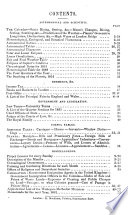 | Pierre Simon marquis de Laplace - Astronomy - 1809 - 406 pages
...supported by the suffrage of every period, had opposed to him; he discovered that the orbit of Mars is an ellipse, of which the Sun occupies one of the foci, and that the motion of the planet is such, that the radius vector, drawn from its centre to that of... | |
 | Edward T W. Polehampton - Astronomy - 1815 - 568 pages
...discovered by Kepler; and which have been fully confirmed by subsequent observations. These laws are, I. The orbit of each planet is an ellipse ; of which the sun occupies one of the foci. The extremity of the major axis of this, ellipse, nearest the sun, is .called the perihelion ; the... | |
 | Edward Polehampton - 1815 - 592 pages
...and which have been fully confirmed by subsequent observations. These laws are, I. The orhit ofjcach planet is an ellipse ; of which the sun occupies one of the foci. The extremity of the major axis of this ellipse, nearest the sun, is called the perihelion ; the opposite... | |
 | Edward Polehampton, John Mason Good - Natural history - 1818 - 590 pages
...then increases, in an inverse manner, till the planet arrives again at its perihelion. .. ', . II. The areas, described about the sun by the radius vector...the planet, are proportional to the times employed iu describing them. These laws are sufficient for determining the motion of the planets round the sun... | |
 | Alexander Jamieson - Natural history - 1821 - 448 pages
...planetary motion discovered by Kepler; and confirmed by subsequent observations. These laws are, 249. The orbit of each planet is an ellipse; of which the sun occupies one of the foci. That focus is called the lower focus. If we suppose the plane of the earth's orbit, which passes through... | |
 | 1843 - 684 pages
...observations, and are now generally known by the name of " Kepler's laws." These laws are: — 1st. The orbit of each planet is an ellipse; of which the Sun occupies one of the foci. 2d. The areas described about the Sun by the radius vector of the planet, are proportional to the times... | |
 | William Rogerson - 1828 - 482 pages
...subsequent observations, and are now generally known by the name of " Kepler's laws." These laws are, first, the orbit of each planet is an ellipse, of which the Sun occupies one of the foci : second, the areas described about the Sun, by the radius vector of the planet, are proportional to... | |
 | William Augustus Norton - Astronomy - 1839 - 530 pages
...planet [or the line drawn from tht, SUK to the planet] are proportional to the times. 2. The orbit of a planet is an ellipse, of which the sun occupies one of the foci. 3. The squares of the times of revolution of the planets are proportional to the cubes of their mean... | |
 | Augustus Young - Circle-squaring - 1846 - 304 pages
...The areas described by the radius vector of a planet are proportional to the times. 2. The orbit of a planet is an ellipse, of which the sun occupies one of the foci. 3. The squares of the times of revolution of the planets are proportional to the cubes of their mean... | |
 | W.H.C. BARTLETT,LL.D., - 1865 - 494 pages
...about its axis by about jj-g- of a sidereal second. THE EARTH'S ORBIT. § 178. The orbit of the earth is an ellipse, of which the sun occupies one of the foci. § 179. The extremities of the transverse axis of the orbit are called the Apsides ; that most remote... | |
| |